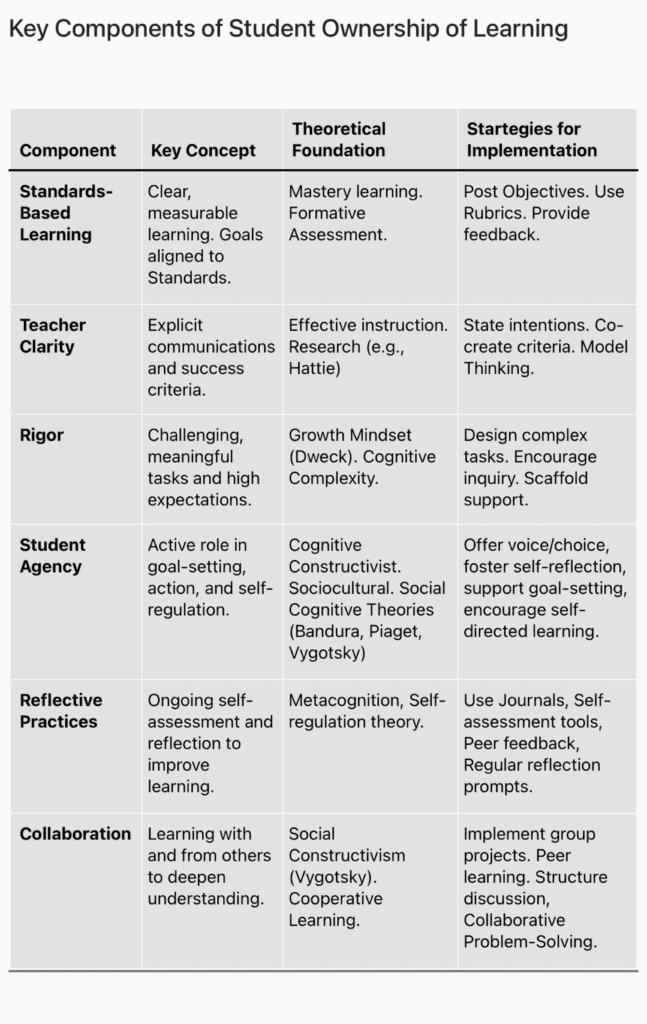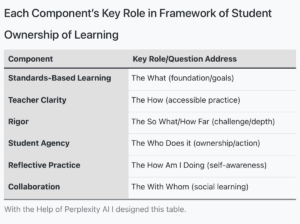What does student ownership of learning mean?
Student ownership of learning means students take responsibility for their learning process, set goals, make decisions, and monitor their progress with course content. It empowers students to achieve greater student engagement in their education, fostering independence, critical thinking, and deeper understanding of the material.

Importance of Student Ownership in Learning
Student ownership is vital, as it fosters independence, critical thinking, and deeper engagement with the material. When students take charge of their education, they become more motivated and invested in their outcomes, leading to improved academic performance and personal growth. This sense of ownership encourages them to set goals, seek resources, and reflect on their learning processes, ultimately cultivating lifelong learning habits. By giving students the opportunity to make choices about their learning, educators help them develop essential skills needed for success in school and beyond.
How to Foster Ownership of Learning
To help educators and students understand how to foster student ownership of learning, the table below highlights the essential components that make this possible. Each component—standards-based learning, teacher clarity, rigor, and student agency—is defined by its key concept and theoretical foundation, while practical strategies show how to put these ideas into action. Together, these elements create a powerful framework for empowering students to take charge of their learning journey[8][10][6].
I developed Student Ownership of Learning Framework with the help of Perplexity AI.
Essential Components of Ownership of Learning

Concise Component Sections for student ownership of learning, each described in a focused paragraph that covers the key concept, theoretical foundation, benefits, and strategies for implementation:
Standards-Based Learning
Standards-based learning centers on aligning classroom goals and assessments with clear, measurable standards. Grounded in mastery learning and formative assessment theory, this approach ensures that students always know what is expected of them and how their progress will be evaluated. The primary benefit is increased transparency, which empowers students to set goals, track their progress, and take responsibility for meeting learning targets. Strategies for implementation include posting learning objectives, using standards-based rubrics, and providing regular, actionable feedback so students can self-assess and adjust their learning strategies accordingly[5][4].
Teacher Clarity
Teacher clarity involves explicitly communicating learning intentions, success criteria, and the relevance of content. Theoretically, it draws on research showing that clear expectations and feedback are essential for effective learning and student engagement. When students understand what they are learning, why it matters, and how to achieve success, they become more motivated and confident in their abilities. To implement teacher clarity, educators can co-create rubrics with students, model thinking processes, and consistently reference learning goals throughout instruction to ensure all students are on the same page[2][4].
Rigor
Rigor refers to creating a learning environment where students are challenged with meaningful, complex tasks that require critical thinking, problem-solving, and perseverance. The foundation of rigor lies in cognitive complexity and growth mindset theory, emphasizing that all students can achieve at high levels with the right support. The benefits include deeper understanding, resilience, and the ability to transfer knowledge to new situations. Educators can foster rigor by designing authentic learning experiences, encouraging inquiry and debate, and scaffolding challenging assignments so that all students are both supported and stretched in their learning[5][4].
Student Agency
Student agency is the capacity of students to act independently, make choices, and take charge of their learning journey. Rooted in constructivist and self-determination theory, agency is both a driver and an outcome of ownership: students who have agency are more engaged, motivated, and invested in their success. The benefits include increased motivation, self-efficacy, and lifelong learning skills. To build agency, teachers can offer voice and choice in assignments, invite student input in lesson planning, and encourage self-reflection and goal-setting as regular classroom practices[6][4].
Reflection and Collaboration
Reflection and collaboration are essential mechanisms for fostering ownership. Reflection enables students to internalize feedback, recognize their strengths and areas for growth, and develop metacognitive skills. Collaboration, meanwhile, builds social and communication skills, allowing students to learn from peers and contribute to group success. Both are grounded in social learning and metacognition theory. Benefits include greater self-awareness, accountability, and a sense of belonging. Teachers can implement these components through structured journals, peer feedback sessions, and cooperative learning activities that require students to work together and reflect on their learning experiences[4][2].
Key Relationship Table
A table summarizing how Standards-Based Learning, Teacher Clarity,Rigor, and Student Agency work together to support student ownership:

Here is a summary table of each component’s key role in the framework of student ownership of learning.

How Integration Works Between Each Component
Standards-Based Learning and Teacher Clarity
Standards-based learning and teacher clarity are deeply interconnected, as clear standards provide the foundation for teachers to communicate precise learning intentions and success criteria to students. When teachers analyze standards to develop learning objectives, they ensure that students know exactly what they are expected to learn, why it matters, and how they will demonstrate mastery. This transparency not only guides instructional planning but also empowers students to self-assess and monitor their progress, making learning goals explicit and actionable.
Check out From Clarity to Ownership: Make Standards Meaningful for Students
Teacher Clarity and Rigor
Teacher clarity is essential for making rigor accessible and meaningful. By clearly articulating challenging expectations and providing structured guidance, teachers help students understand complex tasks and higher-order thinking requirements. Clarity reduces ambiguity, allowing students to focus their cognitive resources on engaging deeply with rigorous content rather than deciphering unclear instructions. This connection ensures that all students, regardless of background, have equitable access to high-level learning opportunities and are supported in meeting ambitious goals.
Rigor and Student Agency
Rigor and student agency are mutually reinforcing. True rigor is not about increasing workload but about fostering deep understanding, critical thinking, and the ability to transfer knowledge to new contexts. When students are challenged with meaningful, complex tasks and supported to reflect, revise, and apply their learning, they develop self-regulation, resilience, and independence—hallmarks of agency. Rigorous environments encourage students to set goals, monitor their progress, and make informed decisions, shifting them from passive compliance to active ownership of their learning journey.
Standards-Based Learning and Student Agency
Standards-based learning supports student agency by providing clear, measurable goals that students can use to set personal learning targets and track their growth. When students understand the standards and are involved in co-creating success criteria, they are better equipped to self-assess, seek feedback, and take responsibility for their progress. This process cultivates a growth mindset, as students see learning as a journey toward mastery rather than a one-time event, and are encouraged to persist and improve through practice and reflection.
Integrative Impact
The cross-links among standards-based learning, teacher clarity, rigor, and student agency create a powerful, student-centered learning environment. Standards and clarity provide the “what” and “how,” rigor ensures meaningful challenge and depth, and agency empowers students to take action and ownership. Together, these elements foster a culture where students are not just recipients of knowledge but active participants, capable of navigating complex tasks, reflecting on their progress, and applying their learning in authentic, real-world contexts.
Download Your Free Teacher’s Guide
Strategic Learning Practices: A Teacher’s Guide to Curriculum, Instruction, and Assessment
